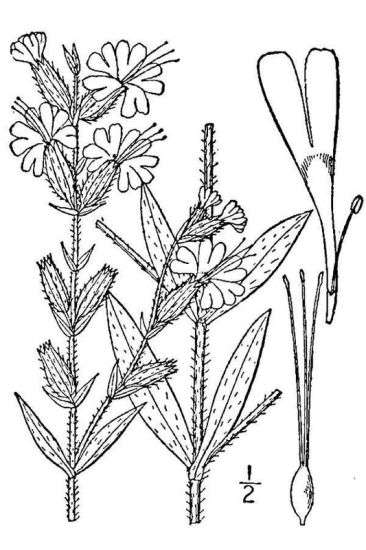 (des sources variées, pas inclus dans Coste) :
(des sources variées, pas inclus dans Coste) :
(D'après Coste, forme de Silene conica L., q.v.) 20-70 cm à longs poils non-glanduleux ; inflorescence à deux cymes unipares en V. Pedicelles très courts (1-2 mm)
Écologie : Moissons, friches, alluvions des courses d'eau. Très rare en toute le France. Native Italie à la Mediterranée est, Iran, Siberie ouest
Répartition hors de France : inconnu
 (modified from Butcher, British Flora 1961):
(modified from Butcher, British Flora 1961):
NOTE: the French text is more complete and up-to-date
Annual or biennial, 30-50 cm Stem erect, upper part branching (usually 2-branched), coarsely haired.
Ecology UK: (distribution according to flora) Harbours and wasteland. Also hay fields. Native to Altay, Baltic States, Belarus, Bulgaria, Central European Rus, Cyprus, East Aegean Is., Greece, Hungary, Iran, Iraq, Italy, Kazakhstan, Kriti, Krym, Lebanon-Syria, North Caucasus, Northwest European R, Palestine, Romania, South European Russi, Transcaucasus, Turkey, Turkey-in-Europe, Ukraine, West Siberia, Yugoslavia
Fleurs : blanches 10-15 cm Calices à 10 nervures hérissées de longs poils. Pétales blancs et profondément échancrés.
Floraison France : Mai-juillet
Flowers: Corolla regular, white, approx. 3-4 cm wide, petals 5, tips deeply notched. Throat of corolla with lobed corona [coronal scale?]. Calyx fused, 10-veined, cylindrical or quite oval at base, 15-18 mm hairy. Stamens 10. Pistil of 3 fused carpels, styles 3. Flowers almost stalkless, (half-)nodding in same direction, fragrant. Inflorescence a quite abundantly-flowered raceme. Usually 2. Its flowers don't usually open completely until the twilight or on cloudy days
Flowering UK: July-September.

 Catchfly, Forked
Catchfly, Forked
 Silène bifurqué
Silène bifurqué









 Please
consider
Please
consider 











